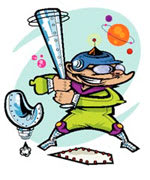Field of Dreams Sports eyewear companies lay out their strategies and fantasies for design and their predictions for the future in lenses, materials, technology, and styling in the category By Erinn Morgan Illustration by Raul Ferran/Fresh Jive Sports eyewear is arguably one of the most advanced segments of this industry in terms of product design. It is also one of the most recognizable eyewear products to consumers. Although it has had its ups and downs in business trends and sell-throughs in the past several years, the category is on an upturn and business is strong. Many say this is due to consumer interest in new technologies in the design of sports eyewear frames and lenses. Experts predict this excitement in new styling and features will continue in a strong way over the next several years. Here, we ask several key players in the sports eyewear market where their products are headed in the short and long term. Will we ever have a dial-a-lens option to switch the tint of our lenses? Might we ever purchase a ski or inline skate helmet which has sports eyewear already integrated into it? Is it possible to have a computer screen image imprinted on the interior of our lenses? Read on to find out the fact and fiction of the future of design.
In the Beginning The process all begins with a sketch and a computer rendering. "Our engineers sit down in front of the computer and design on a 3-D system even before we go to prototype," says Paul Craig, president of Rudy Project USA, the U.S. division of the Italian company known for its expertise in sports lenses, adjustable systems, and wearable designs. "We have a computer simulation model to try the sunglasses on and do problem simulations." Once the computer design is set, a prototype is typically made and tested for efficiency and performance. More and more manufacturers are finding it of utmost importance to perform clinical research on the products they will bring to the market. "We like to do studies to find out if it enhances an athlete's performance," says Chris Farmer, product manager at Boll�. At Nike Vision sports eyewear, manufactured and distributed by Marchon Eyewear, prototypes are created and their performance is tested long before the product itself is finished. "This gives us the ability to get better feedback and make meaningful changes in the product before it ever hits the market," says Robert Barnette, R&D director at Nike Vision. "As with our footwear, our athletes are an integral part of the process." He also notes that their lenses require the same level of engineering as the frames. "We will never buy commodity lenses," he says. "We have a patented technology called Max Lens." Additionally, the company says they are going well beyond acuity studies for lenses and looking into the actual science of light and color. "We have retained Dr. Alan Reichow of Pacific University to work with us to help produce the best lenses for various sports endeavors," says Barnette. Fast Times With the design process always advancing due to testing and technology, there is no doubt that sports eyewear will continue to offer features that provide the wearer with increased performance and comfort. "One thing we're already doing is airventing," says Rudy Project's Craig. "Our 'Kerosene' family of products has airvents which you can deploy, but it also has a platform that allows you to change the placement of the lens on your face and cheekbones. High-tech materials such as titanium and copper berrylium (a lot less expensive than titanium) have entered the market as well as specialized nylons and carbon fiber. "We use a lot of Grilamid," says Craig. "It's a form of plastic which tries to simulate the flexibility of carbon fiber. So if you sit on them they don't snap like plastic, and they also retain their shape. In our design, one of the challenges is how to incorporate the benefits of carbon fiber into sports eyewear." One trend that is just coming into play right now and will gain momentum in the future is flash mirrors. "The advantage is that you can take a tan or brown lens-which is great for skiing but might look ugly in a black or brown frame," says Jim Sepanek, vice president of product development at Timberland Eyewear, "and put a flash mirror on it, which makes it look great." Imagine This Looking torward the next two to five years, sports eyewear companies say there are several key trends that will arise. They will provide for more individuality in fit and function for consumers. "What will separate designs apart is the adjustability of the sports sunglasses," says Craig. "We will see more movement toward hand-adjustable systems for nosepads and temples, which will in turn increase sell-through because people want customized products. We think the future in design comes down to incorporating unique technologies and materials so each person has their own customized fit." In fact, Craig mentions that his slogan for selling this concept is, "Not everyone has a factory head." Another direction will bring "integrated types" of products into the market. "You may see a Rollerblade helmet with sunwear in it," says Timberland's Sepanek. "It's clearly a functional item with a fashion twist. And with the increasing popularity of skiing helmets, we may see a hybrid of a ski helmet and a sunglass." The sport-specific eyewear trend is also expected to continue and become even more specialized. "From a design perspective, the marketplace will evolve into specific-use type of stuff," adds Sepanek. Another likely direction is a dial-a-density system for lenses. "You can effectively choose how much light you let into the lens," says Craig. According to Sepanek, there are currently glass lens products on the market which allow the consumer to make adjustment in light levels. But he says that it "may be difficult to achieve a purely sport product with this feature. It will change too slowly," he says. "Even a photochromic is too slow. If an athlete is riding a mountain bike and needs to change light conditions quickly, what we have now is just too slow." But the future may soon bring a workable system to the market.
The Future-Materials One of the main areas of changes will be in frame materials. Part of this is due to the current proliferation of nylon. "Everyone is using nylon," says Craig. "We think nylon has played its day in court because you just cannot differentiate a $99 product from a $9 knockoff. Consumers ask, 'What is so different about expensive nylon?'" The experts suggest that dual-material products will increase. You will see much more use of mixed materials from us in the future," says Brent Costner, category marketing manager for Nike Vision. Flexible, bendable, and adaptable materials will also be important. In fact, Marchon is launching a collection of Nike Vision optical and sunglass frames next month that feature Flexon material frames. Lighter and thinner eyewear will also be a push going forward. "Less than an ounce is a good benchmark for lightweight sunglasses," says Craig. Thus, many also mention titanium as a material that will get more play in the future, but some say it has limitations because of its high cost. Another lighter weight option is magnesium and according to Sepanek, it is "one material that could come into play once some of its issues are solved such as its flammability." The bottom line is that athletes-and their demand for peak performance products-will drive manufacturers to explore all the options. "A lot of athletes just don't want another piece of equipment," says Sepanek. "Whoever can give them eyewear that is lightweight and virtually invisible will be the most successful." The Future-Lenses It's not just frames that will see interesting advancements in the coming years. Lenses will also follow this lead. "Overall, we will see a general increase in the quality of lenses over the next five years in terms of performance," says Craig. "We will also see a lot of niche positioning in lenses. "New companies will come out to tackle specific needs. And we will see much more sophisticated niching in lens technology," meaning that lenses will be designed to meet the needs of athletes performing specific sports. For example, Boll� currently has lenses designed to enhance a golfer's game. Experts say that lenses will be developed in the future specifically for sports such as mountain biking, cross country skiing, tennis, and baseball. Some say that polarization will be another area that will see many advances. "The biggest thing that will happen is polarized technology that can be injected into a sunglass shield," says Sepanek. "This will give us a lot of design freedom to create product with a much lighter weight." This will ultimately lead to great increases in the amount of polarized sports eyewear on the market. "About 50 percent of our business has been polarized, and that will increase to 60 or 75 percent in the next few years," says Boll�'s Farmer. Additionally, some say that the quality and effectiveness of scratch resistance is an issue that will be addressed by lens manufacturers in the very near future. "The general durability of lenses will improve," says Conrad Casser, general manager of Carrera Sport eyewear, distributed by S�filo. "Anti-scratch and anti-fog materials will become more widely used, and anti-fog material will become more scratch resistant." And, as mentioned before, many say that lenses will be introduced where the light density coming into the lens can be adjusted. "Controlling or changing the density of light will be next big horizon," says Craig. Carrera already has a proprietary lens that filters light at specific levels (nanometers) to accomplish increased contrast and depth perception. "We hope to introduce this for sport applications soon," says Casser. "Currently it is only available in glass, which is not the best material for sport use."
The Future-Frames The actual shape and styling of sports eyewear frames is not expected to change that much in the coming years, as many athletes have welcomed the effectiveness of the wraparound in blocking light. The one style many cite as making a comeback is the shield. And once polarized technology changes and can be injected into shields, they will be even more readily accepted," says Sepanek. Others say shields will make a comeback because they fit a lot of different face shapes. "Shields are coming back in a big way," says Farmer. "The difficulty has been in trying to fit a lot of different lens cuts to a lot of different faces. That's why the shield works. It just fits a lot of faces." Finally, manufacturers agree that a major trend in sports eyewear will be toward sports-specific products. And, likely, manufacturers will begin to find their own niches to tackle. "We've picked out a niche like cross country skiing to focus on," says Craig. "There are 400,000 enthusiasts, and it's a great focus for a small company." Farmer agrees: "We definitely want to stay close to where Boll� started and that's in sports-specific product. For biking, golfing, etcetera." Far Out What advances will the next five or 10 years bring to the sports eyewear arena? Most agree that the direction will continue to go toward more specific uses. "In the next 10 years you'll see more sunglasses that meet consumer needs in specific sports issues and problems," says Craig. He also surmises that we may see a lens that is completely scratch-resistant in the next 10 years which also has better optics. "The labs are working on that right now," says Craig. "We will also see advances in coatings." In general, more sports eyewear will feature options for a customized fit. "The capability of customizing a frame for the individual face will become more refined," says Casser. And it will also become more portable. "Designs to allow for easier portability-such as folding flat to fit into pockets and self cases-will emerge," he says. As eyewear becomes more sports-specific, many say that the face of manufacturing itself will change. "We'll see more and more niche players," says Craig. "They will pick out certain sports to focus on. And we'll see a breakdown in the market of the big people who will start to think like little players." EB
|
Article
Field of Dreams
Sports eyewear companies lay out their strategies and fantasies for design and their predictions for the future in lenses, materials, technology, and styling in the category
Eyecare Business
February 1, 2001







